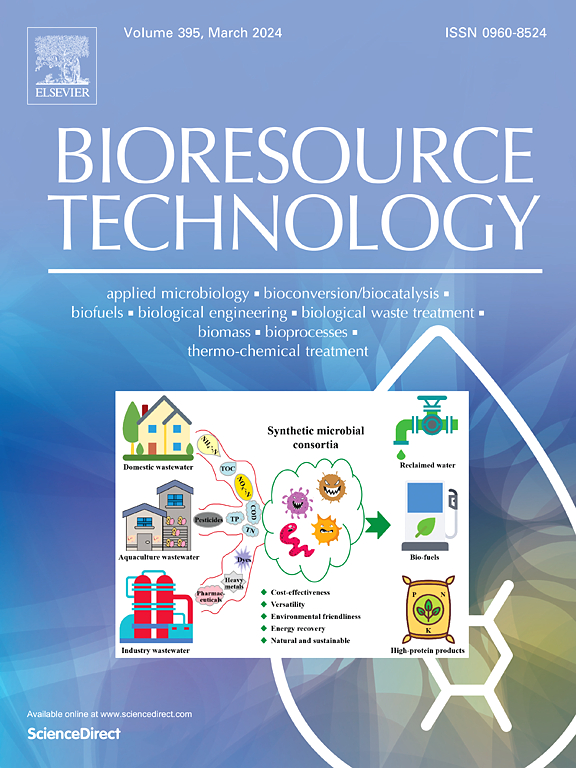利用地衣进行无菌和非无菌固体生物处理农用工业废物增值的比较分析。
IF 9
1区 环境科学与生态学
Q1 AGRICULTURAL ENGINEERING
引用次数: 0
摘要
本研究探讨了在无菌和非无菌条件下,拉莫沙衣虫(Lichtheimia ramosa)在多种工农业废弃物固态生物处理(SSB)中的生物技术潜力。以分解木屑为主要基质,辅以麦麸、动物粪便、屠宰场污泥、奶牛场废弃物、苹果渣和尿素等辅助基质。28天的SSB试验表明,基质组成发生了显著变化,氮含量显著增加(非无菌麦麸处理高达34.58 %),C:N比值相应降低,表明有机质矿化增强。酶活性谱显示L. ramosa具有强大的木质纤维素分解能力,观察到底物特异性酶诱导模式。在无菌条件下,添加麦麸的酶活性最高,CMCase达到0.71 U/g, β-葡萄糖苷酶达到0.82 U/g,淀粉酶达到7.85 U/g。在非无菌系统中,微生物的协同相互作用是明显的,木聚糖酶活性在第7天达到峰值(2.31 U/g),比无菌条件下更早,这表明混合微生物群优先降解半纤维素。研究表明,系统无菌性、底物组成和氮源相互作用影响水解效率和酶产量。麦麸、屠宰场污泥和新鲜乳制品固体成为优化生物转化过程最有效的共底物。这些发现突出了L. ramosa在废物增值方面的多功能生物催化剂潜力,无菌系统被推荐用于靶向木质纤维素酶的生产,而非无菌系统有利于有机废物的矿化。本文章由计算机程序翻译,如有差异,请以英文原文为准。
Comparative analysis of sterile and non-sterile solid-state bioprocessing using Lichtheimia ramosa for agro-industrial waste valorization
This study investigated the biotechnological potential of Lichtheimia ramosa in the solid-state bioprocessing (SSB) of various agro-industrial and agricultural residues under both sterile and non-sterile conditions. Decomposing wood sawdust was used as the primary substrate, supplemented with different co-substrates including wheat bran, animal manures, slaughterhouse sludge, dairy wastes, apple pomace, and urea. The 28-day SSB experiments revealed significant changes in substrate composition, with notable increases in nitrogen content (up to 34.58 % in non-sterile wheat bran treatment) and corresponding reductions in C:N ratios, indicating enhanced organic matter mineralization. Enzymatic activity profiles demonstrated L. ramosa’s robust lignocellulolytic capabilities, with substrate-specific enzyme induction patterns observed. Under sterile conditions, wheat bran supplementation yielded the highest enzymatic activities, with CMCase reaching 0.71 U/g, β-glucosidase 0.82 U/g, and amylase 7.85 U/g. In non-sterile systems, cooperative microbial interactions were evident, with xylanase activity peaking earlier (2.31 U/g at day 7) than in sterile conditions, suggesting preferential hemicellulose degradation by the mixed microbiota. The study revealed that system sterility, substrate composition, and nitrogen source interactively influenced hydrolysis efficiency and enzyme production. Wheat bran, slaughterhouse sludge, and fresh dairy solids emerged as the most effective co-substrates for optimizing bioconversion processes. These findings highlight L. ramosa’s versatile biocatalyst potential for waste valorization, with sterile systems recommended for targeted lignocellulase production and non-sterile systems beneficial for organic waste mineralization.
求助全文
通过发布文献求助,成功后即可免费获取论文全文。
去求助
来源期刊

Bioresource Technology
工程技术-能源与燃料
CiteScore
20.80
自引率
19.30%
发文量
2013
审稿时长
12 days
期刊介绍:
Bioresource Technology publishes original articles, review articles, case studies, and short communications covering the fundamentals, applications, and management of bioresource technology. The journal seeks to advance and disseminate knowledge across various areas related to biomass, biological waste treatment, bioenergy, biotransformations, bioresource systems analysis, and associated conversion or production technologies.
Topics include:
• Biofuels: liquid and gaseous biofuels production, modeling and economics
• Bioprocesses and bioproducts: biocatalysis and fermentations
• Biomass and feedstocks utilization: bioconversion of agro-industrial residues
• Environmental protection: biological waste treatment
• Thermochemical conversion of biomass: combustion, pyrolysis, gasification, catalysis.
 求助内容:
求助内容: 应助结果提醒方式:
应助结果提醒方式:


